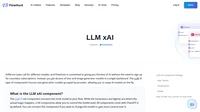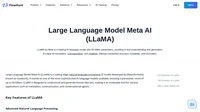Apache MXNet is an open-source deep learning framework designed to train and deploy deep neural networks efficiently and flexibly. It stands out for its scalability, supporting fast model training, and offering a flexible programming model that accommodates multiple languages. MXNet is particularly known for its ability to blend symbolic and imperative programming to maximize both efficiency and productivity, making it a preferred choice for researchers, developers, and data scientists working in the field of artificial intelligence (AI).
Key Features of Apache MXNet
Hybrid Front-End: Imperative and Symbolic Programming
Apache MXNet introduces a hybrid programming model that seamlessly integrates imperative and symbolic programming paradigms. This hybrid front-end allows developers to benefit from the ease of imperative programming, where operations are executed immediately and results are obtained instantly, and the efficiency of symbolic programming, which involves defining computational graphs that are optimized and executed later.
- Imperative Programming: Offers flexibility and is intuitive for developers familiar with procedural coding. It allows for interactive debugging and is suitable for dynamic neural network architectures.
- Symbolic Programming: Enables optimization opportunities by defining computation graphs. This approach is efficient for deploying models in production environments where performance is critical.
By combining these paradigms, MXNet provides an environment where developers can prototype models quickly and then optimize them for high-performance execution without rewriting code.
Multiple Language Support
One of MXNet’s notable strengths is its support for a wide range of programming languages. Developers can work with languages they are most comfortable with, including:
- Python
- C++
- R
- Scala
- Julia
- Java
- JavaScript
- Go
- Perl
- Matlab
This multilingual support enables a broader community of developers to adopt MXNet, fostering collaboration and accelerating development in diverse projects.
Scalability and Performance
MXNet is designed with scalability at its core. It efficiently utilizes hardware resources, supporting distributed training across multiple GPUs and machines. This capability allows for:
- Linear Scaling: The ability to increase training speed almost linearly with the addition of more GPUs or CPUs.
- Distributed Training: MXNet leverages a distributed parameter server architecture, facilitating scalable distributed training and performance optimization in both research and production settings.
Such scalability is crucial for training large, complex models on vast datasets, reducing training time significantly.
Portability
The framework is highly portable, enabling the deployment of trained models on a wide array of devices, from high-end servers to low-powered edge devices like mobile phones, Raspberry Pi, and Internet of Things (IoT) devices. This portability ensures that models can run efficiently in various environments, making MXNet suitable for applications that require on-device inference without relying on cloud infrastructure.
Ecosystem of Tools and Libraries
MXNet boasts a thriving ecosystem that extends its capabilities through specialized toolkits and libraries:
- Gluon API: Provides high-level abstractions for building neural networks, making it easier to prototype, train, and deploy models without sacrificing performance.
- GluonCV: A toolkit for computer vision tasks, offering a rich model zoo for object detection, image classification, segmentation, and more.
- GluonNLP: Focuses on natural language processing, providing state-of-the-art models and tools for building NLP applications.
- GluonTS: A toolkit for probabilistic time series modeling, facilitating the development of forecasting models.
These tools help streamline the development process for specific AI domains, enabling practitioners to build sophisticated models with less effort.
How Is Apache MXNet Used?
Building Deep Learning Models
MXNet is utilized for creating and training deep learning models, such as convolutional neural networks (CNNs) for image recognition and recurrent neural networks (RNNs) like long short-term memory (LSTM) networks for sequential data. Its flexibility allows developers to design custom neural network architectures tailored to specific tasks.
Key aspects include:
- Fast Prototyping: Using the Gluon API, developers can quickly build and iterate over models.
- Efficient Training: With support for hybrid programming, models can be optimized for performance without extensive code modification.
- Easy Deployment: Trained models can be exported and deployed on various platforms and devices.
AI Automation and Chatbots
In the context of AI automation and chatbots, MXNet plays a significant role by providing tools and models that facilitate natural language understanding and generation. Developers can leverage GluonNLP to:
- Build Language Models: Create models that understand and generate human language, essential for chatbots and conversational agents.
- Sequence-to-Sequence Models: Implement models for machine translation, text summarization, and dialogue systems.
- Pre-trained Embeddings: Use word embeddings like Word2Vec and GloVe to represent text data efficiently.
By utilizing these capabilities, developers can create intelligent chatbots that understand user queries and provide relevant responses, enhancing user experience in various applications.
Distributed Training
MXNet’s support for distributed training allows for handling large-scale machine learning tasks. By distributing computations across multiple GPUs and machines, it enables:
- Handling Large Datasets: Processes big data efficiently by parallelizing operations.
- Accelerated Training: Reduces training time significantly, which is crucial for iterative development and model refinement.
- Scalability in Production: Supports scaling models in production environments to accommodate growing demands.
Integration with Cloud Services
MXNet is integrated with major cloud service providers, particularly Amazon Web Services (AWS), which adopted MXNet as its deep learning framework of choice. This integration provides:
- Managed Services: Platforms like Amazon SageMaker enable users to build, train, and deploy MXNet models without managing the underlying infrastructure.
- Serverless Deployment: Utilizing services like AWS Lambda for deploying models in a serverless architecture.
- Edge Deployment: With AWS Greengrass, models can be deployed to edge devices, enabling real-time data processing.
Comparison with Other Deep Learning Frameworks
While several deep learning frameworks are available, MXNet offers unique advantages:
Apache MXNet is a versatile and powerful deep learning framework that offers a blend of performance, flexibility, and scalability. Its support for multiple programming languages, hybrid programming model, and rich ecosystem make it suitable for a wide range of AI applications, including AI automation and chatbot development. By facilitating efficient model training and deployment across various platforms, MXNet empowers developers and organizations to build advanced AI solutions that meet the demands of today’s technology landscape.
Research on Apache MXNet
Apache MXNet is a versatile deep learning framework that has been the subject of various academic studies. Below are some key research articles that explore different aspects and applications of Apache MXNet:
- GluonCV and GluonNLP: Deep Learning in Computer Vision and Natural Language Processing
This research, authored by Jian Guo et al., introduces GluonCV and GluonNLP toolkits, which are based on Apache MXNet. These toolkits provide state-of-the-art pre-trained models, training scripts, and logs, facilitating rapid prototyping and reproducible research. They offer modular APIs with flexible building blocks for efficient customization. The paper discusses how these models can be deployed across various platforms and programming languages, leveraging the MXNet ecosystem. The toolkits are distributed under the Apache 2.0 license, allowing for broad use and modification. Read more - BMXNet: An Open-Source Binary Neural Network Implementation Based on MXNet
Haojin Yang and colleagues present BMXNet, an open-source library for Binary Neural Networks (BNNs) built on MXNet. BNNs are highlighted for their ability to reduce memory usage and energy consumption through bit-wise operations. BMXNet supports XNOR-Networks and Quantized Neural Networks, operating seamlessly in both GPU and CPU modes. The paper details extensive experiments validating BMXNet’s efficiency and effectiveness, with resources available for download to facilitate further research and application. Read more - Symbolic Techniques for Deep Learning: Challenges and Opportunities
In this survey, Belinda Fang et al. explore the use of symbolic techniques in prominent deep learning frameworks, including MXNet. The paper examines how symbolic execution, graphs, and programming are leveraged within these frameworks, influencing neural network construction and execution. The study highlights MXNet’s Gluon API, which integrates imperative programming with symbolic execution, opening up new possibilities for enhanced performance through symbolic techniques. Read more
MIT Researchers Unveil New Insights and Tools for Large Language Models
Discover MIT's latest breakthroughs in large language models, enhancing real-world applications and anomaly detection. Dive into future AI insights!
Large Language Model Meta AI (LLaMA)
Discover Meta's LLaMA: a powerful 65B-parameter AI for translation, summarization, and chatbots, setting new benchmarks in language processing.



